Dutch National Day ! HNLMS Karel Doorman (R81) was the only cold war Dutch aircraft carrier. She was a Colossus-class ship, part of the 1942 light fleet aircraft carrier programme as the former HMS Venerable. She was sold in 1948 to the Royal Netherlands Navy. Her partial modernization was later completed with an angle deck to operate jets. In 1960, she took part in the Western New Guinea – Indonesia war. Later her role was changed to a pure anti-submarine warfare carrier with ASW aircraft and helicopters as per NATO framework. She could have a few more years of service, but an accidental engine room fire while under refit prompted her end of service in 1968. She was sold to Argentina in 1969 and became ARA Veinticinco de Mayo, which took part in the Falklands war. #koninklijkemarine #dutchnavy #kareldoorman #aircraftcarrier
HMS Venerable

HMS Venerable in 1945. She was a veteran of the Pacific campaign
HMS Venerable was one of the last light fleet aircraft carriers operational in time in world war two. She entered service in January 1945. However by 1947, like many other Royal Navy carriers, she was considered surplus and in the context of post-war budget cuts, she was mothballed. Like many other carriers of her class and those close to it, she was proposed on sale by the British Government at very affordable price.
The previous HNLMS Karel Doorman, the ex-HMS Nairana of the Vindex class.
This allowed many naval forces to get acquire their first own aircraft carrier, and the Netherlands were no exception. Not only the Dutch (merchant) Navy already operated two merchant aircraft carriers during the war (MACs had a hangar, a lift and could operate three swordfish) but there was plenty of support for the idea of a carrier-based task force, or ideally two, one at home, another to guarantee the Dutch East Indies, in 1946. The idea was further refined and theorized in 1947-49. It’s the 1950 naval plan that solidified all this. But the carrier was purchased on the base of the 1948 plan. HMS Venerable was acquired on the first of April 1948.
In addition, in 1946 the former escort carrier HMS Nairana was loaned to the Dutch Navy.
She was renamed HNLMS Karel Doorman, and operated 14 Firefly F.1. She was loaned officially by the NL Navy on 23 March 1946 and decommissioned on 28 May 1948, Returned to Royal Navy. She could provide an experienced air crew and personal which served both on Nairana from Dec. 1943 as well as on Gadila, Macoma, but also HMS Colossus, which had some Dutch crew. Sure, these two merchant carriers and an escort carrier were nothing like a fully fledged fleet carrier, but this was a crucial core of solid experience nonetheless that comforted the Dutch admiralty in its choices.
During her active life, HNLMS Karel Doorman would have several refits and reconstructions. The initial one was in 1947-48 before being transferred to the Netherlands Navy.
Overall Design
Hull and Layout
She differed not a lot from the original vessel with an overall displacement of 19,900 tons, for an overall length of 192 m (629 ft 11 in), a Beam at the waterline of 24.4 m (80 ft 1 in) and a Draught of 7.5 m (24 ft 7 in). Her initial complement in 1948 was 1,300 with the air group and personal. Protection, was unchanged compared to the Colossus class, with a fully armored Belt and decks protected by max 190 mm or 7 inches. Mantlets protected the aircraft torpedoes warheads magazine, 10 mm (0.4 in). There were also longitudinal watertight bulkheads covering the machinery.
For more, an exhaustive study of the Colossus class had been done, check it up.
Powerplant
No changes either, with her original two propeller shafts driven by two Parsons geared steam turbines, fed by the superheated steam coming from her four Admiralty 3-drum boilers and a total installed power of 40,000 shp (30 MW), top speed of 25 knots (46 km/h; 29 mph). This was not stellar for fleet service, but by the fifties, a high top speed was no longer that important. She aldh had her powerplant updated later in her career, by 1965-66, with HMS Leviathan’s unused powerplant. However a machinery fire put an end to her career soon afterwards.
Armament
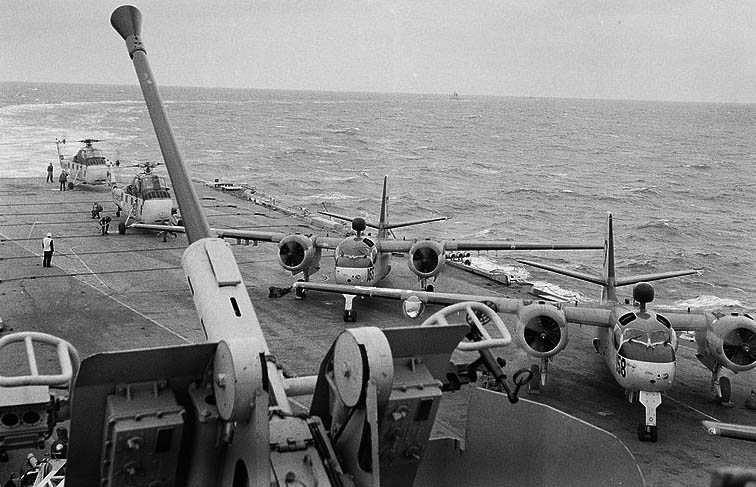
Initially, HNLMS Karel Doorman came out with a very large AA defence setup, twenty-one 40mm/60 Mk III Bofors and six quad 40mm/39 Mk VII (so 45 in all), instead of her WW2 AA complement with Pompom and Oerlikons (6×4 2pdr pompom AA, 16x 20 mm Oerlikon AA). These also all came with radar-assisted guidance. After her 1955-1958 major reconstruction this was changed again: She now had only twelve single 40mm/70 Bofors Model 1958 with new radar assistance. Her first line of defense were her escorts and own fighters.
Sensors
Karel Doorman’s electronics suite started not with Venerable’s WW2 suite but an updated one:
Type 79B, Type 281B, six type 282 radars for the Bofors, type 144 sonar.
In 1955-58 it was considerably modernized, and entirely home-built. She had for it a brand new and unique derrick style lattice, with four legs mast and a taller funnel; It supported a LW-02 air surface search antenna coupled with a LW-01 long range surveillance radar and a DA-01 combined air/sea search radar as well as a VI-01 nodding height finder plus new sensors, the ZW-01 navigation radar above the bridge. The new 40 mm Bofors mountings were placed on each quadrant and either end of the island and were assisted by better radars as well.
The new suite:
-LW-01: (Lucht Waarschuwingsradar or “air warning radar”) L-band, long-range air search, 11 x 4.88 m, 1.45 metric tons antenna. pulsewidth 3 µs, PP 600 kW, 2 kW avg, range 140 nm (260 km) accuracy 500 m. Wind deflectors, 5J26 magnetron transmitter. Developed between 1949 and 1952 as SGR-114/06. Used also on the Dutch cruisers.
-LW-02: Search set 7.8 x 4.25 m, 0,95 tons, 1-10 rpm, same transmitter. Frq 1350 MHz L-band PP 600 kW RA 140 nm (260 km).
-DA-01: (Doels Aanwijzing, “target indication”) S band air/sea surveillance, med-range & target indication. RA 50 nm or 90 km
-2x VI-01: Fire control radars for the Bofors, conventional nodding-beam radar feed and antenna moving together.
-ZW-01: HD surface search radar, X-band, pwd 1 µs range 50 nm.
-Sonar Removed.
Air Facilities
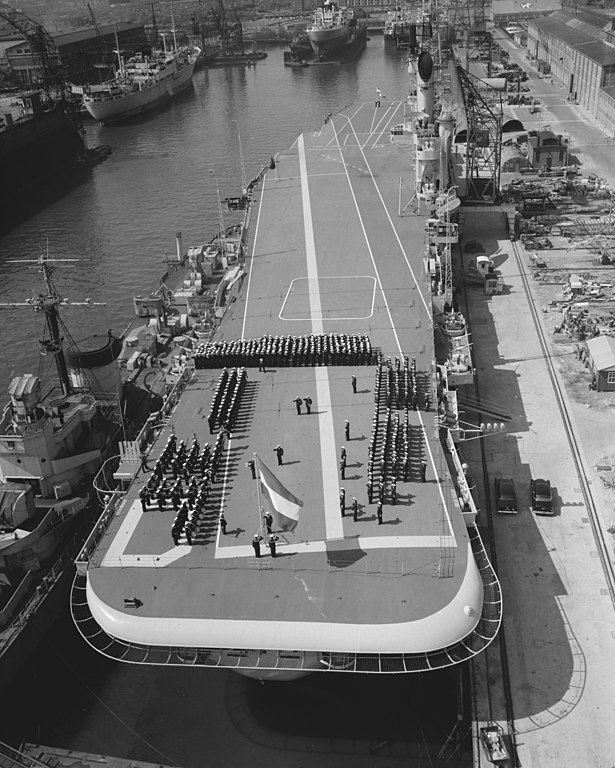
Originally her deck was straight like a regular colossus carrier, her flight deck measured 210.3 meters long and 24.4 meters wide, for a total area of 5,131m². Her hangar measured 135.6 meters in lenght, 15.8 meters wide and 5.3m high. Total surface area was 2,142m² of an internal volume of 11,355m³. Sne had two lifts measuring 13.7 meters long, 10.4 meters wide for 6.8t capacity. There was forward a single catapult BH-III (capable of launching a 6.4t aircraft at 122km/h). Aircraft fuel stowage was 448,200l.
In 1955-58 she had a new refit, here is the detail
-New 165.8m angled (8°) deck installed, overall beam 37m
-Catapult replaced by BS-4
-New arresting gear
In 1967-69 a new refit was supposed to enhance ASW support of helicopters and the large prop planes SH-2 trackers, but the details are not known.
Another unknown is the possible upgrade of her visual landing system.
Air Group

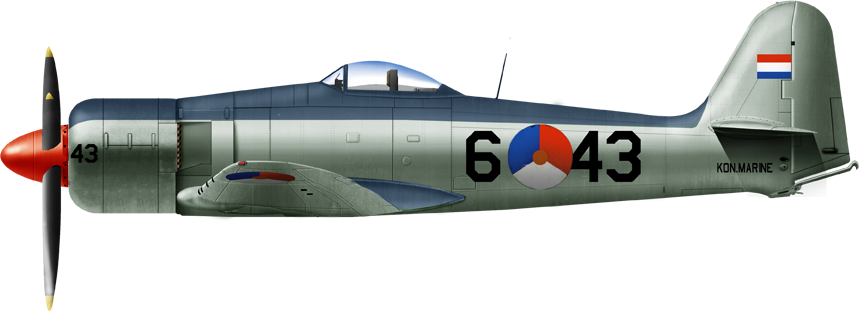
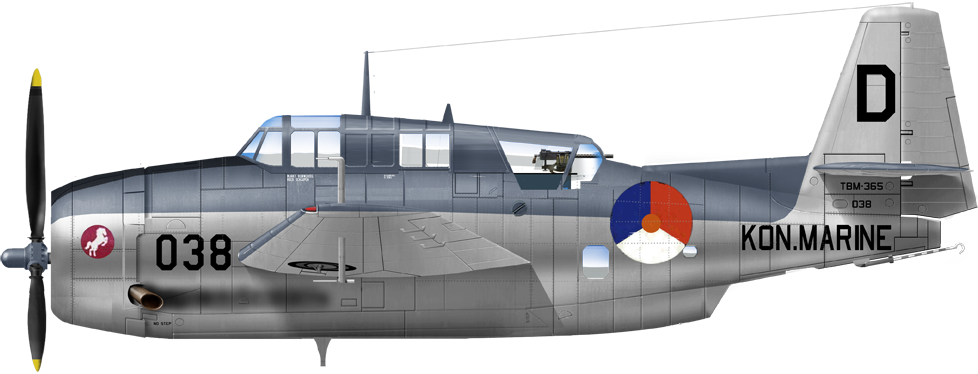
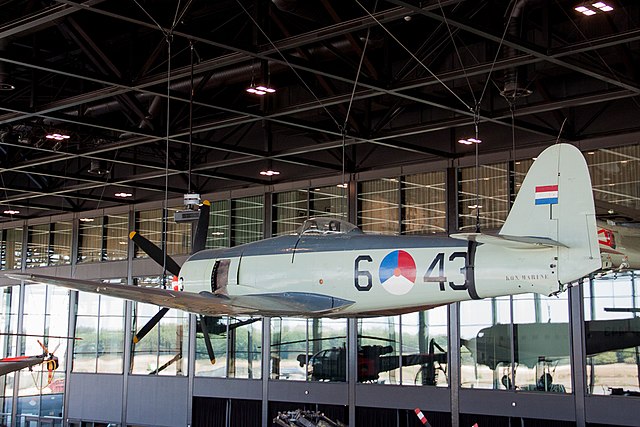
For practical reasons, her initial aircraft park consisted of Sea Fury FB 11 and Firefly ASW aircraft, purchased as she was transferred. In addition 23 Sea Fury FB 15 were later built under licence in the Netherlands. The Dutch Navy operated the Firefly in its VSQ-1 to VSQ-7 and VSQ-860 squadrons.
So as of 1948, she carried ten Sea Fury FB.11 and 9 Firefly AS.4/5.
In 1952, her port forward pair of AA was later removed to clear the end of the angled deck and her air group changed in time. She operated 23 Sea Fury Mk50 at that time.
After her 1957-58 refit, she operated a modern air group, with six Sea Hawk FGA.6, six TBM-3 Avenger and four Sikorsky HSS-1N Seabat helicopters, two used for ASW and two for SAR.
After her last revolution as an ASW carrier, she carried eight S-2A Tracker and six SH-34J Seabat helicopters.
These were S2F-1 Tracker ASW planes, two-engine, with a long range, widespread in other ex-Colossus class carriers in service during the latter cold war. She was indeed refitted accordingly to the last naval plan, to be the center of an ASW hunter-killer group.
Second reconstruction
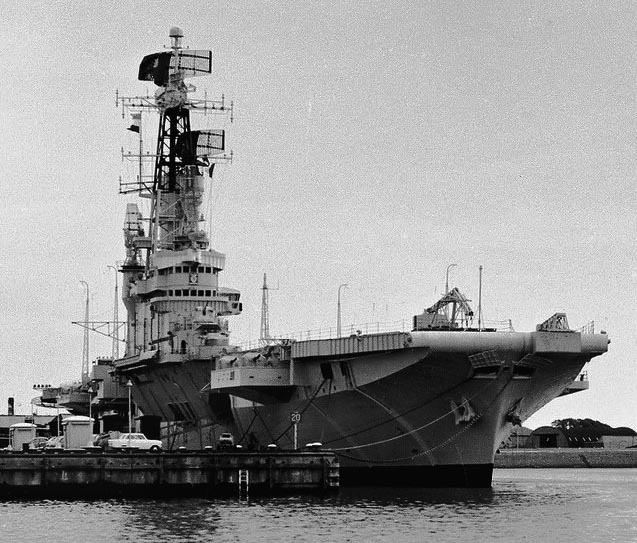
In the 1953-54 there was a deep survey to decide the fate of the carrier, as she could have being either scrapped or modernized. But the report shown her general excellent state, hull integrity, well running machinery and equipments all around. A modernization was decided, but it was radical and made her the true “Dutch Carrier” she is remembered for, quite unique in the series of 1942 fleet carriers postwar.
Both her hull and flight deck were modified in order to operate jets, and Wilton-Fijenoord was chhosn for the task, with plans provided by British yards after similar conversions. This was indeed a very long immobilization, between 1955 and 1958. Her final deck was added extra lenght at both ends for 165.50 m overall, the flight deck was entiirely replaced, reinforced and much reinforced, she had a new angled deck, and a much more powerful steam catapult (instead of hydraulic) fitted on her port side forward, as well as a new mirror landing sight. This new configuration allowed simultaneous recovery and launch of heavier jets. The arrester gear wa salso upgraded, plus new tanks for avgas were installed, with a double capacity.
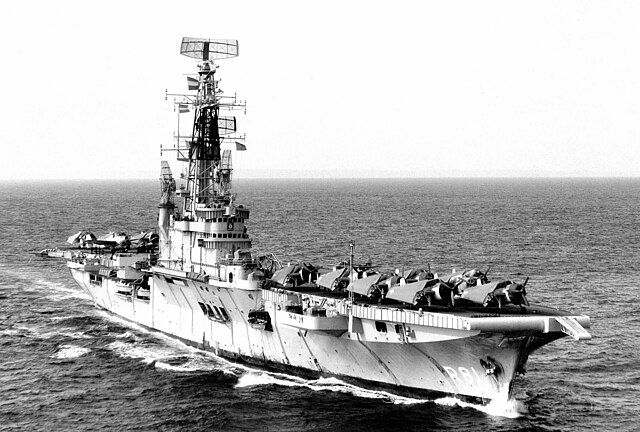
The internal arrangements was also completely revised, all pipings, electric wiring, climatization system, communication, noth internal and external, the whole radar suite, etc.
The AA was also modernized, ending with twelve single 40 mm Bofors mountings on sensible quadrants and guided by new radars.
In 1965-66 she was reboilered in drydock with the machinery of the uncompleted carrier Leviathan.
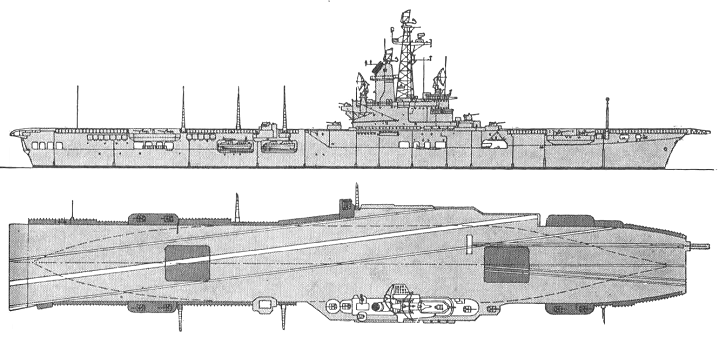
⚙ specifications |
|
| Displacement | 15.892 tonnes standard, 18,986 tonnes FL |
| Dimensions | 211.3 x 24.4 (37 deck after rebuilding) x 7.6 m |
| Propulsion | 2x shafts Parsons geared steam turbines, 4 boilers, 40,000 shp |
| Speed | 23.5 knots |
| Range | 12,000 nm range |
| Armament | 12 x 40mm AA |
| Protection | See notes |
| Sensors | Radars LW-01, LW-02, DA-01, Guiding VI-01, ZW-01 |
| Air Group | 21 aircraft (see notes) |
| Crew | 1300-1400 |
Career of HtMs Karel Doorman
The Man, Karel Doorman
 Karel Willem Frederik Marie Doorman (23 April 1889 – 28 February 1942) was a Dutch naval officer made famous in World War II as he commanded the remnants of the short-lived American-British-Dutch-Australian (ABDA) Command naval strike forces in the Battle of the Java Sea. He died on his flagship HNLMS De Ruyter, torpedoed during the battle, going down with her. His last fighting words, made famous (and controversial) were allegedly “I am attacking, follow me”.
Karel Willem Frederik Marie Doorman (23 April 1889 – 28 February 1942) was a Dutch naval officer made famous in World War II as he commanded the remnants of the short-lived American-British-Dutch-Australian (ABDA) Command naval strike forces in the Battle of the Java Sea. He died on his flagship HNLMS De Ruyter, torpedoed during the battle, going down with her. His last fighting words, made famous (and controversial) were allegedly “I am attacking, follow me”.
The reason he was chosen as namesake for the carriers was his commitment with naval aviation early on; By mid-1915 first naval officers to be awarded his pilot wings. He also commanded a Naval Air Base from 1919 to 1921 and was awarded Knight of the Order of Orange-Nassau in 1922 as an organizer of naval aviation. Later he was at the head of Hague’s Naval Aviation department and in 1938 he was commanding the whole Naval Aviation in the Dutch East Indies.
A short Carrer
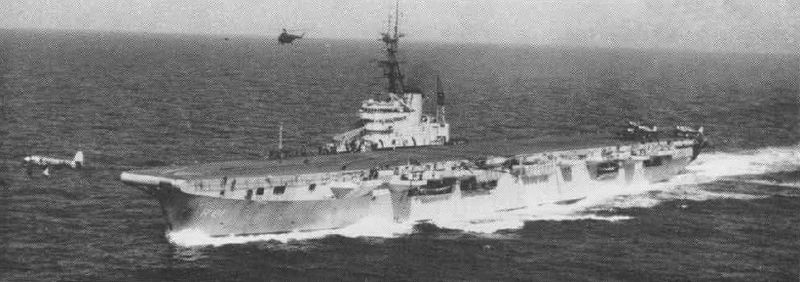
Karel Doorman launching a Sea Fury in the 1950s
After commission, HNLMS Karel Doorman trained in 1949 until declared fully qualified in all departments and start operational service. She departed with the frigate Johan Maurits van Nassau and light cruiser Jacob van Heemskerck to the Netherlands Antilles (Caribbean) on 2 January 1950 with Prince Bernhard on board. After a tour of the Dutch West Indies, the carrier was back to the Netherlands on 4 May. Nothing of note for 1951-53.
In 1954 she started North American cruise, visiting Montreal and Quebec down the St lawrence in Canada and took part in an air show.
Nothing to note in 1955-59 apart her two years refit and reconstruction in the netherlands, details above.
Early in 1959 she returned to the United States, stopping at Newport, Rhode Island and Fort Lauderdale in Florida and returned to the Dutch Antilles.
In 1960, the Dutch colony of Western New Guinea was negociating independence, and there was a territorial dispute with the former colony of the East Indies, Indonesia, which also claimed it. The Dutch government was forced to intervene, and sent Karel Doorman with its task force, protected by two destroyers and a modified oil tanker, all to “show the flag”. The problem even before being there was to cross the Suez canal. Indeed following the non-aligned countries alliance, Egypt, an objective and active ally of Indonesia was likely to forbid passage into the Suez Canal. So, to avoid this pitfall the Dutch admiralty choose the “long road”, so she sailed around the Horn of Africa.
She arrived in Fremantle (Australia) just to be surrounded by local seamen’s union’s ships, on strike, in sympathy with Indonesia. The tug’s crews refused to help the carrier while in port. Having no tugs at hands, the air commander aboard took a very unusual decision, likely not to be repeated again: All propellers of aicraft chained down on deck were used by thrust alone to maneuver the ship to dock. They managed to nudge the carrier into dock.
The carrier was also loaded by no less than twelve Hawker Hunter fighters to reinforce the local Dutch squadron, delivered at Hollandia in New Guinea. Karel Doorman afterwards visited Yokohama as the glowing point of her Asian cruise. There, she was tocelebrate the 350th anniversary of Japanese-Dutch diplomatic relations. Yet again strong official Indonesian (and local) protestations had the invitation cancelled. The carrier showed the flag and served her purpose, albeit there were some close call with a very hostile Inonesian aviation, that obliged the carrier to practice quite a gymkhana to exit the maze of islands while avoiding Indonesian national waters. She was flew over by freshly acquired bombers by Indonesia still, and her CAP was on high alert all time. But a direct confrontation was avoided. But things would repeat later. She was back home in 1961. Nothing to note in 1962-63.
The carrier then went into her third major refit of her carrer. Sher was drydocked and completely gutted, with her whole machinery was replaced by the one planned in UK for the incomplete HMS Leviathan, purchased for that purpose. The new machinery gave her a boost of 42,000hp and 24.5kts.
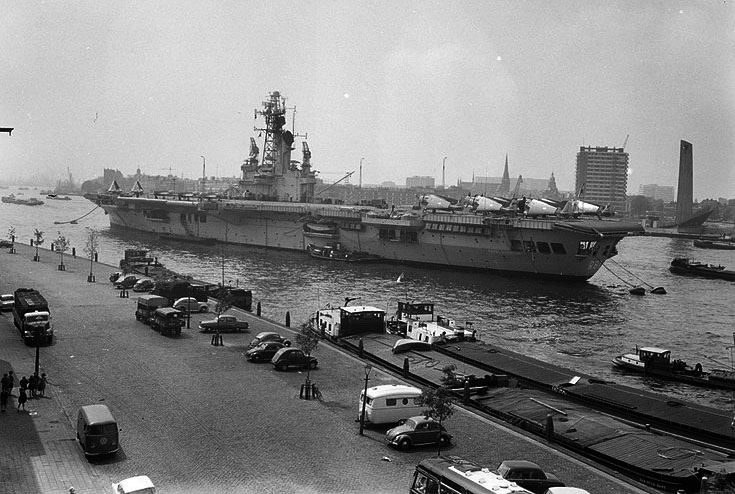
Karel Doorman leaving Amsterdam for New Guinea
After her 1964 refit, she was repurposed as ASW carrier, and her air group was changed in accordance. She would serve the rest of her career within NATO north Atlantic anti-soviet subs patrol system, and no longer carried strike or fighter aircraft. As she was integrated into NATO’s ASW panel, she conducted many intensive exercises near Scotland, notably to perform tasks in accordance of the GIUK gap defence tactics.
Her role in postcolonial conflicts was not however done yet. She took part lastly in the Western New Guinea Crisis.
This even is also called the Western New Guinea Dispute. She took part as a response to Indonesia’s Operation Trikora. Indonesia indeed prepared a military action, a fully fledged invasion covered by the Indonesian Air Forces (TNI-AU). The later was reinforced by recently Soviet-supplied Tupolev Tu-16KS-1 Badger naval bombers. The later used the AS-1 Kennel or KS-1 Kometa anti-ship missiles. Six were pepared and trained specificaly to attack and sink the Karel Doorman. It is even suspected Soviet instructors were present during the training. After all this was a good opportunity to test tactics against western carriers regularly met in the Atlantic. However at the last minute, the missile strike mission was cancelled as the ceasefire between Indonesia and the Netherlands was announced. The Dutch withdrawal under United Nation’s supervision, and sending a temporary peacekeeping force, ensre a peaceful handover of Western New Guinea to Indonesia. But political tensions never ceased to this day.

In 1964, after loosing its colonial territories and recent NATO mission focus radical changes, the Dutch Admiralty estimated its forces were no longer tailored or adapted to the mission. Its two cruisers would be decommissioned as well as the carrier they were to protected, and the numerous destroyers of the Holland/Friesland class to be modernized and/or decommissioned in turn. In exchange, a new set of missile guided frigates would be built, notably the very successful Kortenaer class. The huge costs associated to operate and maintaining HNLMS Karel Dooman forcd the decision to retire her. But it was planned for 1972-73, just as the newly acquired long range maritime patrol aircraft would take over her ASW role over the north Atlantic.
But fate would decided otherwise: An accidental boiler room fire broke out on 26 April 1968. It was estimated the repair cost was too much for a meter few years of useful service, so it prompted her earluer decommissioning. Still, the fire damage was repaired and new boilers transplanted from HMS Leviathan at Wilton-Fijenoord, Rotterdam, nit to prolongate her service to to resell her. Indeed since 1969, nogociations with the Argentine government, already operating the closely related carrier Independencia since 1958, made relevant the acquisition of a new, more modern carrier. The transfer was effective and she was renamed Veinticinco de Mayo, later to play an important role in the 1982 Falklands War.
A note about the active air group of Karel Doorman
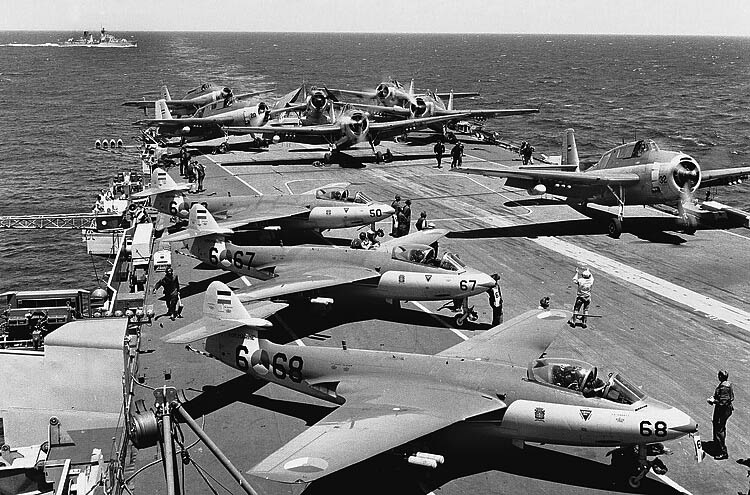
The “full monty”, Sea Hawk, Avengers and helicopters aboard post-1958.
Initially the carrier came out with a WW2 style air group, the latest ASW Firefly, also usable for strikes, and the postwar last-prop Sea Fury, also usable for strikes. Less well known, she also had a single Supermarine Sea Otter flying boat for reconnaissance and liaison, until replaced (as unpractical) by a Sikorsky S-51 helicopter.
From 1958, she kept her 14 Grumman TBF Avenger park completed by ten Hawker Sea Hawk fighters, which were nearly obsolete when adopted, there were also two Sikorsky S-55 ASW helicopters.
From 1959, these Sea Hawks were at last provided Sidewinder missiles, greatly improving their capabilities. They played their part as carrier-based deterrent in the 1962 New Guinea Indonesia crisis. They were retired in 1964 for the overhaul, and transferred to land bases, then retired in 1969 as the carrier was sold.
In the late 1960s, the era of decolonization behind, the Dutch admiralty focused at last on local defence as part of NATO. It was engaged in an anti-submarine commitment, which bulk was provided by the Westland Wasp helicopters operated by six Van Speijk-class anti-submarine frigates plus two squadrons of shore-based maritime patrol aircraft, split between Breguet Atlantique and P-2 Neptunes. On the carrier, questions were asked to replace the on board Sea Hawks and ASW Avenger squadrons. The latter comprised both the TBM-3S2 (anti-submarine) and TBM-3W2 (airborne early warning radar) types, but they were ultimately replaced by a new twon-prop all in one model compatible with her small flight deck, the S2F-1 Tracker. These were Canadian built and for her last air park she combined these eight Grumman S-2 Trackers with six Sikorsky S-58 ASW helicopters from 1961 until 1968. This ensured she could provide at least three trackers in ASW patrol at all time, the rest in maintenance as well as three helicopters, for two search bubbles around the fleet. Still for these assets, this was paid quite high. A consideration taken seriously after her 1968 fire.
Read More/Src
Books
W.H.E., van Amstel (1991). De schepen van de Koninklijke Marine vanaf 1945. Alkmaar: De Alk. ISBN 9060139976.
Brand, Bert (2005). Hr. Ms. Karel Doorman: vliegveld in zee. Emmen: Lanasta. ISBN 9086160018.
Geneste, Willem (1990). Verguisd en geprezen: Hr. Ms. Karel Doorman. Bergen: Bonneville. ISBN 9073304024.
Hoog, Arie (1991). De dikke boot: herinneringen aan Hr. Ms. Karel Doorman. Bergen: Bonneville. ISBN 9073304067.
Kop, H.J.E. van der (1982). Vliegkampschepen: geschiedenis en ontwikkeling van het vliegkampschip Hr. Ms. Karel Doorman in de Koninklijke Marine. Bussum: De Boer maritiem. ISBN 9022818551.
Kooger, Hans (1999). Het enige vliegkampschip van Nederland; de wereld van de carriers en herinneringen aan Hr. Ms. Karel Doorman. Berkel en Rodenrijs: Nederlandse Historiën.
Hellema, Duco (2005). De Karel Doorman In Nieuw-Guinea: Nederlands Machtsvertoon In De Oost. Amsterdam: Boom. ISBN 9789085061823.
Cats, Jacques (2014). Viermaal Karel Doorman. de Drvkkery Schrijverspodium. ISBN 9789081585644.
Slot, Rob Bruins (1 November 2005). “Karel Doorman” (in Dutch). Andere Tijden. Retrieved 8 March 2018.
Karremann, Jaime (2 June 2014). “Karel Doorman vliegkampschip (1948)” (in Dutch). marineschepen.nl. Retrieved 8 March 2018.
Links
vlaggeschipsmaldeel5.nl commandanten
vlaggeschipsmaldeel5.nl
seaforces.org/
THE HIGH SEAS: Flying Dutchman, Sept. 19, 1960
uboat.net/
hazegray.org/
naval-history.net/
netherlandsnavy.nl
commons.wikimedia.org/
steelnavy.com KDoorman.htm
en.wikipedia.org HNLMS Karel Doorman
navypedia.org/
Videos

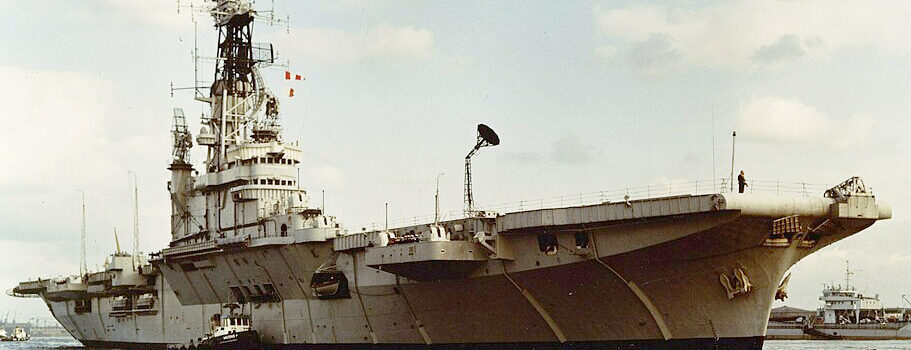

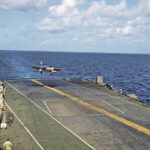
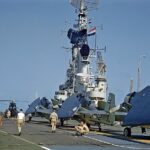
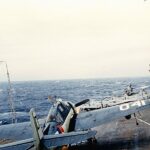
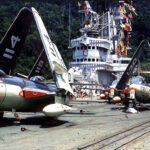
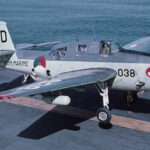
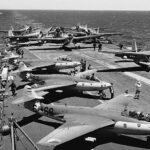
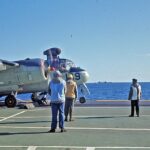
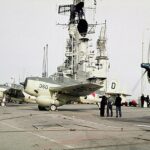
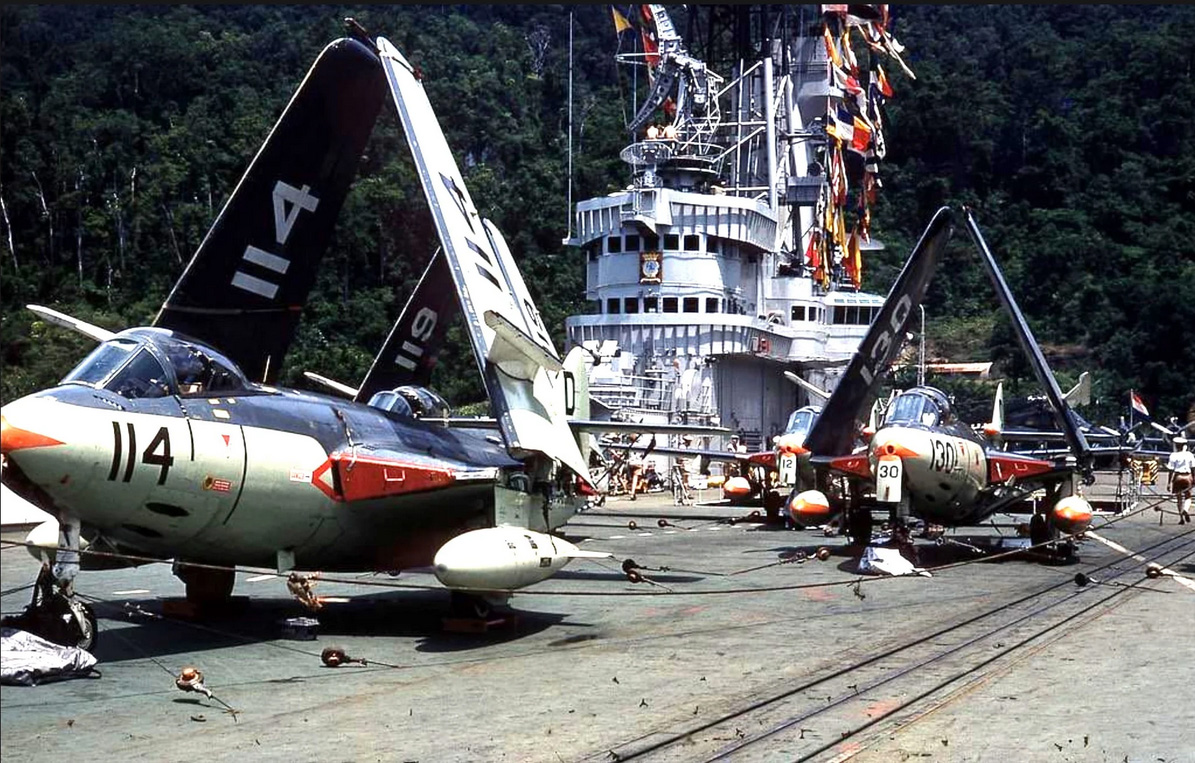

 Latest Facebook Entry -
Latest Facebook Entry -  X(Tweeter) Naval Encyclopedia's deck archive
X(Tweeter) Naval Encyclopedia's deck archive Instagram (@navalencyc)
Instagram (@navalencyc)





 French Navy
French Navy Royal Navy
Royal Navy Russian Navy
Russian Navy Armada Espanola
Armada Espanola Austrian Navy
Austrian Navy K.u.K. Kriegsmarine
K.u.K. Kriegsmarine Dansk Marine
Dansk Marine Nautiko Hellenon
Nautiko Hellenon Koninklije Marine 1870
Koninklije Marine 1870 Marinha do Brasil
Marinha do Brasil Osmanlı Donanması
Osmanlı Donanması Marina Do Peru
Marina Do Peru Marinha do Portugal
Marinha do Portugal Regia Marina 1870
Regia Marina 1870 Nihhon Kaigun 1870
Nihhon Kaigun 1870 Preußische Marine 1870
Preußische Marine 1870 Russkiy Flot 1870
Russkiy Flot 1870 Svenska marinen
Svenska marinen Søværnet
Søværnet Union Navy
Union Navy Confederate Navy
Confederate Navy Armada de Argentina
Armada de Argentina Imperial Chinese Navy
Imperial Chinese Navy Marinha do Portugal
Marinha do Portugal Mexico
Mexico Kaiserliche Marine
Kaiserliche Marine 1898 US Navy
1898 US Navy Sovietskiy Flot
Sovietskiy Flot Royal Canadian Navy
Royal Canadian Navy Royal Australian Navy
Royal Australian Navy RNZN Fleet
RNZN Fleet Chinese Navy 1937
Chinese Navy 1937 Kriegsmarine
Kriegsmarine Chilean Navy
Chilean Navy Danish Navy
Danish Navy Finnish Navy
Finnish Navy Hellenic Navy
Hellenic Navy Polish Navy
Polish Navy Romanian Navy
Romanian Navy Turkish Navy
Turkish Navy Royal Yugoslav Navy
Royal Yugoslav Navy Royal Thai Navy
Royal Thai Navy Minor Navies
Minor Navies Albania
Albania Austria
Austria Belgium
Belgium Columbia
Columbia Costa Rica
Costa Rica Cuba
Cuba Czechoslovakia
Czechoslovakia Dominican Republic
Dominican Republic Haiti
Haiti Hungary
Hungary Honduras
Honduras Estonia
Estonia Iceland
Iceland Eire
Eire Equador
Equador Iran
Iran Iraq
Iraq Latvia
Latvia Liberia
Liberia Lithuania
Lithuania Mandchukuo
Mandchukuo Morocco
Morocco Nicaragua
Nicaragua Persia
Persia San Salvador
San Salvador Sarawak
Sarawak Uruguay
Uruguay Venezuela
Venezuela Zanzibar
Zanzibar Warsaw Pact Navies
Warsaw Pact Navies Bulgaria
Bulgaria Hungary
Hungary

 Bundesmarine
Bundesmarine Dutch Navy
Dutch Navy Hellenic Navy
Hellenic Navy Marina Militare
Marina Militare Yugoslav Navy
Yugoslav Navy Chinese Navy
Chinese Navy Indian Navy
Indian Navy Indonesian Navy
Indonesian Navy JMSDF
JMSDF North Korean Navy
North Korean Navy Pakistani Navy
Pakistani Navy Philippines Navy
Philippines Navy ROKN
ROKN Rep. of Singapore Navy
Rep. of Singapore Navy Taiwanese Navy
Taiwanese Navy IDF Navy
IDF Navy Saudi Navy
Saudi Navy Royal New Zealand Navy
Royal New Zealand Navy Egyptian Navy
Egyptian Navy South African Navy
South African Navy






























 Ukrainian Navy
Ukrainian Navy dbodesign
dbodesign